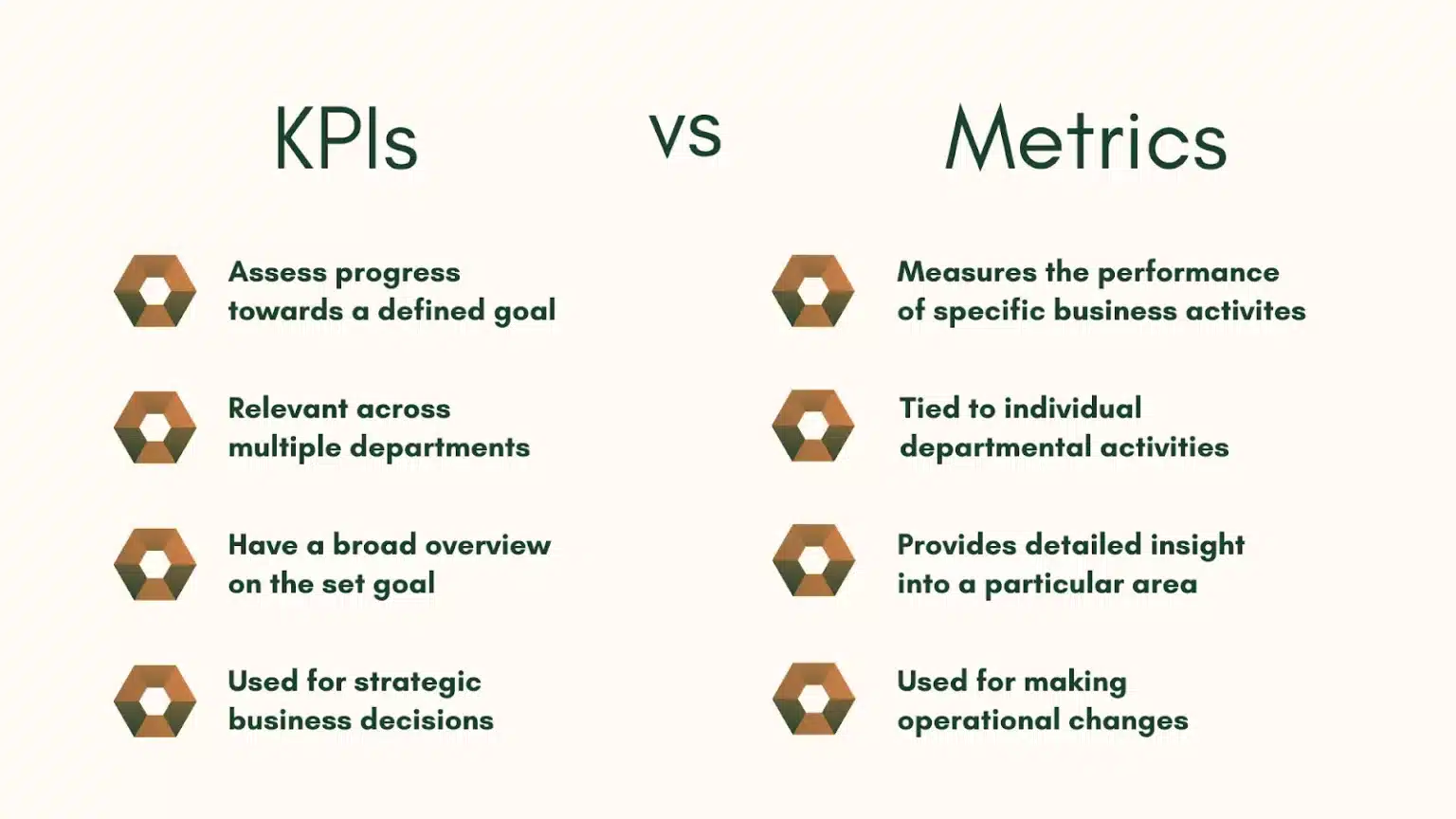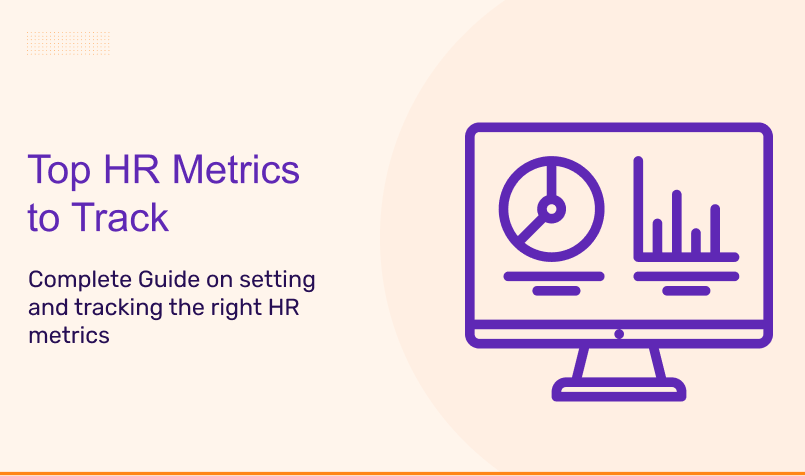As businesses continue to evolve in this rapidly changing landscape, the importance of data-driven decision-making in human resources has never been clearer. In today’s dynamic environment, where talent acquisition, retention, and development are paramount, having a solid understanding of the right HR metrics is crucial for organizational success.
Choosing the right HR metrics isn’t just about collecting data for the sake of it. It’s about gaining actionable insights that drive strategic HR initiatives and ultimately contribute to the bottom line. Whether you’re a seasoned HR professional or just dipping your toes into the world of workforce analytics, having a curated list of metrics tailored to your organization’s goals can make all the difference.
To help you with this, we’ve identified 40+ HR metrics and KPIs and broken down 21 business-critical ones. Let’s dive right in!
KPIs vs Metrics: What’s the Difference?
Metrics and KPIs are both quantitative measurements of business initiatives and objectives. And, though they often overlap each other, they provide distinct insights into separate areas.
A KPI is a measurable benchmark against a broader, defined goal and can involve the efforts of several departments. A metric, however, provides information regarding specific elements under the same goal.
Here’s an example to understand this better:.
Your company’s objective is to increase sales by 40% by the end of the year. This is a pretty significant initiative and will require multiple departments to work together.
For instance, Marketing may have to ramp up the frequency of campaign deployment. Production teams and sales executives will also have to increase their quota for each quarter.
Now, the primary KPI in this scenario will be sales growth and the efforts of everyone involved will contribute towards the KPI.
However, the metrics in this case will be elements tied to departmental performance, such as:
- Lead-to-Conversion ratio for Sales
- Campaign engagement for Marketing
- Product churn for Production
If you’re still a little lost, here’s a quick summary:

45 HR Metrics to Track for Business Growth
Here is a list of 45 HR metrics to help you find the key metrics that matter to your business:
Hiring Metrics
- Time to Fill
- Cost Per Hire
- Quality of Hire
- Headcount Growth
- Offer Acceptance Rate
- Interview-to-Hire Ratio
- Candidate Satisfaction Score
Onboarding Metrics
- New Hire Turnover
- Time to Productivity
- Onboarding Satisfaction
- Training Completion Rate
Goal-Setting Metrics
- 360-Degree Feedback Scores
- Time to Proficiency For New Hires
Performance Management Metrics
- Performance Ratings
- Goal Completion Rates
- Revenue Per Employee
- Forced Ranking
Employee Engagement Metrics
- Retention Rate
- Average Tenure
- Joiners vs Leavers
- Voluntary Turnover Rate
- Involuntary Turnover Rate
- Employee Sentiment Analysis
- High-Performer Resignation Rate
Training & Development Metrics
- Training Cost Per Employee
- Learner Engagement
- Learner Drop-Off Rate
- Assessment Pass Rate
Diversity, Equity, Inclusion, and Belonging Metrics
- Diversity Ratio
- Inclusion Index
- Employee Demographics (Age, Ethnic & Gender Distribution)
- ERG Participation Rate
Benefits & Compensation Metrics
- Pay Equity
- Target Percentile
- Range Penetration
- Benefits Utilization
- Total Cost of Workforce
Leave Management Metrics
- Leave Utilization Rate
Compliances Metrics
- Time to Resolve Compliance Issues
- Employee Grievances Filed
- Incidents of Non-Compliance
Employee Satisfaction Metrics
- Employee Net Promoter Score (NPS)
- Absenteeism Rate
- Attrition Rate
- Average Cost of Attrition
The Ultimate Cheat Sheet for HR Metrics
Below, we’ve analyzed and handpicked 21 of the 46 HR metrics listed above. We want to take a closer look at them since they have a stronger impact on your HR strategy and are interrelated to each other in several ways. To keep things concise, we’ll only be focusing on:
- Why you should track it
- How it helps
- The calculation formula (where applicable)
Let’s get into it.
Hiring Metrics
- Time to Fill
Why you should track:
- Provides a reference point for how long your recruitment process is
- Can act as a forecasting tool to analyze changes in the talent acquisition market
- Serves as a warning signal when your hiring methods are underperforming
How it helps:
Measuring your time to fill will tell you exactly how long it takes to replace an employee with someone with the same professional experience/skills. More importantly, it will enable you to frame your onboarding and handover process to fit this timeline.
The calculation formula:
| Total no. of days to fill all open positions / Total no. of open positions |
- Cost Per Hire (CPH)
Why you should track:
- Allows you to streamline and optimize the overall recruitment budget
- Sets a baseline for the required financial resources for the next hiring period
- Helps isolate irregular expenses by comparing departmental hiring expenditures
How it helps:
Your CPH is a direct representation of your recruitment team’s efficiency. It also acts as a guiding tool to curb unnecessary expenditures during the recruitment phase. You can then redirect those resources to employee training and development.
The calculation formula:

- Quality of Hire (QoH)
Why you should track:
- Provides insight into your recruiter’s understanding of your organizational culture
- Gives a global performance benchmark for the talent acquisition team
- Directly related to workforce productivity (Better quality hires contribute more)
How it helps:
Employees who are more engaged in their work and fit the organizational culture better will naturally be inclined to stay at the company longer. So, tracking QoH essentially results in a more productive team in the long run.
The calculation formula:
| (Indicator A + Indicator B + Indicator C) / Total no. of indicators |
Note: ‘Indicators’ are contextual, employee-related metrics. In the formula above, ‘Indicator A’ can be ‘training time’ and ‘Indicator B’ could be ‘time to promote’. You can assign as many indicators as you want.
- Headcount Growth
Why you should track:
- Helps streamline the allocation of organizational and workforce expenses
- Enables you to anticipate and plan your future recruitment strategy and needs
- Ensures that the growing workforce is aligned with business-critical objectives
How it helps:
Assessing your headcount growth is key to meeting your employees’ needs at every step. It also provides supportive insight into elements such as workforce diversity ratios, employee turnover rates and average tenure.
The calculation formula:

Onboarding Metrics
- New Hire Turnover
Why you should track:
- Pinpoints issues like inadequate vetting or problems in onboarding/ training
- Essential to managing other hiring metrics such as cost per hire
- Reveals redundancies and critical problems in organization culture
How it helps:
Monitoring new hire turnover rates is crucial to set up a balanced workplace environment. In most cases, it will also enable you to identify and prioritize issues in your organizational culture, such as workplace toxicity or a lack of guidance. Addressing them will help make your company more attractive to prospects.
The calculation formula:

- Time to Productivity
Why you should track:
- Highlights the efficiency of your onboarding process
- Helps identify issues in training and development programs
- Provides partial insight into a new employee’s work engagement levels
How it helps:
Time to productivity gives you a peek into the efficiency of your talent management practices. In other cases, if the new employee has especially poor TTP even with a fool-proof training and development program, it lets you know about the quality of the hire.
The calculation formula:
| Total time for a new employee batch to meet assigned KPIs / Total no. of new employees |
Note: For this to work, it is important to have a dedicated KPI system in place.
Goal-Setting Metrics
- 360-Degree Feedback Scores
Why you should track:
- Offers a holistic overview of team-wide engagement and productivity
- Eliminates personal biases from the review process
- Creates a cycle of consistent communication and continuous improvement
How it helps:
Traditional feedback processes are often run by team leads or a single department. Incorporating and monitoring a 360-degree system spreads this responsibility across the entire workforce.
In addition, it helps keep an accurate track of performance-related compensation and incentives. By comparing reports from multiple cycles, you can conclude a team or an individual’s consistent progress and reward them accordingly.
The calculation formula:
Note: Since such reviews integrate open-ended discussion and reporting, there is no standardized way of calculating an aggregate in this case. Competent and objective human analysis is the only way to deal with this metric.
Performance Management Metrics
- Revenue Per Employee (RPE)
Why you should track:
- Direct measurement of how workforce talent translates to customer value
- Allows you to track company-wide productivity and efficiency
- A good indicator of your business’s profitability based on its size and scale
How it helps:
RPE is an excellent marker for assessing changes in employee experience and skills in the long run. For example, if RPE goes up while your team size remains the same for a designated period, it could signify a boost to overall productivity levels.
Combined with other KPIs, it also lets you monitor departmental financial contributions and potential areas of improvement.
The calculation formula:
| Total revenue / Total no. of employees |
Employee Engagement Metrics
- Average Tenure
Why you should track:
- Solid point of reference for employee satisfaction and engagement
- Enables you to identify issues regarding workplace fit and poor management
- Helps analyze your company’s work profile mix (High-value, long-term employees/New employees with fresh suggestions and ideas)
How it helps:
Ideally, you’d want high-value employees to have a considerably longer average tenure. Noticeably shorter ones are strong indicators of something not working as it should. It could be the offered compensation package or a lack of training and guidance.
The key is to identify potential problems at the earliest opportunity and ensure that your employees are motivated to stay with the company.
The calculation formula:
| Total tenure of all employees / Total number of employees |
Note: Current date – Employee start date + 1 (formula for calculating the tenure of an individual employee)
- Joiners vs Leavers
Why you should track:
- Impacts your ability to respond to workplace challenges and market opportunities
- Influences role-based access and control over sensitive company information
- Co-related to other metrics including attrition, retention and headcount growth
How it helps:
Joiners vs Leavers is a critical element in maintaining business and data security. For example, removing/granting access to company information and credentials in a timely fashion can prevent any potential data leaks.
Consistently monitoring changes in your team size will also let you anticipate future productivity levels and plan your project allocations and recruitment needs accordingly.
The calculation formula:
| No. of employees who joined in Period X No. of employees who left in Period X |
- Voluntary Turnover Rate
Why you should track:
- Co-related factor in recruitment, onboarding and training costs
- Can cause additional expenses, such as hiring temporary replacements
- Can be a contributing factor to productivity loss due to missing workplace synergy
How it helps:
Knowing your voluntary turnover rate is key to efficient workflow planning. For example, most often, your current employees will have to pick up the slack in workload until the position is filled.
In some cases, the employee leaving may also be a senior project manager or have a specialized skill set. Filling this gap will require you to balance careful reorganization of work distribution and a suitable time to fill.
The calculation formula:

- Involuntary Turnover Rate
Why you should track:
- Allows you to assess problems with employee behavior and business planning
- Reveals weaknesses in the hiring process (culture fit, QoH, etc)
- Impacts organizational expenses related to training recruits
How it helps:
Involuntary turnover is a direct result of inefficient recruiting methods. By measuring it and the factors behind the termination, you can isolate the specific problems in your hiring process.
For instance, if the employee has consistently poor performance, it means your recruiters aren’t bringing in qualified individuals. However, if the contributing cause behind the termination is misconduct, then cultural fit could be the problem.

Image Source: Voluntary or not, a high turnover rate can be embarrassing
The calculation formula:
Training & Development Metrics
- Training Cost Per Employee
Why you should track:
- Represents company investment in workforce development and growth
- Helps measure the ROI of your training programs
- Identifies opportunities in revamping internal business processes and practices
How it helps:
Training cost per employee is one of the major internal expenses in any company. Balancing training quality and its cost will let you make informed business decisions and ensure your workforce is equipped with the necessary skills without overspending.
The calculation formula:
| Total cost for training a new employee batch / No. of employees in the batch |
Diversity, Equity, Inclusion, and Belonging Metrics
- Diversity Ratio
Why you should track:
- Creates an inclusive culture and helps build a brand-community relationship
- Strengthens employer-employee relationships, employer branding and reputation
- Invites open and creative work-related discussion and a fresh take on challenges
How it helps:
On the surface, diversity ratios help promote workplace inclusivity and bring multiple fresh perspectives to common challenges. However, when your diversity ratio is disproportionate, tracking it can let you identify hiring biases. You can then address these issues to refine recruitment practices.
The calculation formula:

- Employee Demographics (Age, Ethnic & Gender Distribution)
Why you should track:
- Co-related factor in measuring diversity ratio
- Directly influences internal practices such as diversity and sensitivity training
- Helps predict attrition and voluntary turnover rates (based on employee age)
How it helps:
Employee demographic data offers valuable insight into your workforce composition. Combined with the diversity ratio, this allows you to pinpoint inclusion/diversity gaps across your teams. From there, you can mobilize initiatives for better representation and equal opportunities.
The calculation formula:
| Total no. of employees in a specific group (based on age, gender, etc.) |
Benefits & Compensation Metrics
- Pay Equity
Why you should track:
- Prevents discrimination based on cultural, social and gender identities
- Improves workforce morale and productivity
- Attracts talented prospects based on equal pay opportunities
How it helps:
Pay equity is perhaps the most important factor in employee retention. The easiest way to maintain it is to only consider employee contributions/job responsibilities/tenure and disregard other non-essential factors (gender). This also keeps you compliant with legal regulations and prevents any potential discriminatory lawsuits.
The calculation formula:
| (Median salary for Group 1 in Position X) / (Median salary for Group 2 in Position X) |
Note: Groupings are based on selected parameters such as gender or ethnicity
- Total Cost of Workforce (TCOW)
Why you should track:
- Critical to efficient allocation and use of company resources
- Crucial to maintaining adequate staffing and assessing headcount growth
- Helps evaluate prioritization areas (focus on personnel development vs. business growth and performance)
How it helps:
TCOW tells you what workforce changes will cost you to the last penny. This is critical to fully understanding how internal actions and processes (employee termination, voluntary leaving, attrition) impact your company expenses. In addition, you can use TCOW to drive business outcomes that are vital to your success (retaining high-performing employees, etc.).
The calculation formula:
| All compensation + Benefits + Other costs (recruiting, contingents, training, etc.) |
Employee Satisfaction Metrics
- Employee Net Promoter Score (NPS)
Why you should track:
- Lets you gauge employee loyalty and satisfaction in their current role
- Making changes based on NPS data boosts workforce engagement and retention
- An indicator for productivity levels and, therefore, your bottom line
How it helps:
NPS is essentially a free marketing tool for your business. The higher it is, the more likely you are to attract qualified and talented professionals. However, a Low eNPS can result in a poor company reputation in the employment market and shrink your prospect pool.
The calculation formula:

Note: To measure the number of promoters and detractors, host an anonymous survey. Then, ask employees to assign a score of 1-10 based on how likely they are to recommend the company to a friend.
- Absenteeism Rate
Why you should track:
- Allows you to analyze overall organizational health and well-being
- Helps record individual and team workplace engagement, presence and productivity
- Aids in identifying core issues in the work environment in cases of high absenteeism rates
How it helps:
It’s not possible for your company to have zero absenteeism. However, while measuring it, it’s important to note the factors behind the absence. If they are genuine, this could help you set up support channels for those who need it.
In other instances, a high absenteeism rate combined with repeated incidents can mean disengagement on the employee’s part. At this stage, you are better off executing an intervention strategy.
The calculation formula:
| No. of absent days / Total no. of work days in a given period |
- Attrition Rate
Why you should track:
- Critical to evaluating the success of retention strategies
- Solid point of reference for analyzing problems related to workplace culture
- Helps assess organizational dynamics and anticipate future hiring needs
How it helps:
The attrition rate is one of the core components of employee turnover. Besides it being one of the primary markers for workforce loyalty and engagement, it also helps you analyze changes in team dynamics and workload distribution.
For example, measuring departmental attrition (employees transferring to other teams in the same company) will notify you of necessary work reallocations,
The calculation formula:

- Average Cost of Attrition (CoA)
Why you should track:
- Enables you to balance cost per hire according to the resources lost
- Forces you to refine your training and development programs when attrition costs are high
- Highlights poor recruitment channels when the CoA is high among a specific group of former employees (individuals hired from the same channel)
How it helps:
The average CoA isn’t just related to the loss of the company’s financial resources. It also involves the recruitment efforts required to fill the current position/skill gap and the potential dip in employee morale.
So, measuring the CoA at your company will allow you to bring your training programs in line and help streamline your hiring budget and talent acquisition channels.
The calculation formula:
| Total cost of hiring + Onboarding expenses + Expenditure on training |
How to Use HR Metrics Effectively
Let’s face it: Just looking at the number of metrics to track can be overwhelming.
However, it’s not that hard to do. The trick lies in understanding:
- The kind of metric you are dealing with
- How to put the gathered data to use

Image Source: Be like the Cookie Monster
Now, there are 4 broad types of HR metrics, including:
- Quantitative: Focused on concrete numbers and data (Time to fill, average tenure, etc.)
- Qualitative: Offers more subtle insight into company and workforce dynamics (Employee sentiment analysis, 360-degree feedback, etc.)
- Financial: Directly related to the monetary elements of HR functions (CPH, savings generated through redirecting unnecessary recruitment expenses, etc.)
- Outcome-Based: KPIs that need measuring, assessing and acting upon (Diversity ratios, pay equity, etc)
Often, you will find that these 4 types of HR metrics bleed into each other. Case in point:
Time to fill is directly related to CPH. A high CPH can occasionally reduce your available budget for training recruits. That goes on to paint an inaccurate picture of QoH.
You see, one element affects another and so on. So, the key to using HR metrics effectively is to do the following:
- Align broader goals with critical HR functions
Example: Company expansion in the next 5 years = Increased recruitment with better QoH
- Identify the core metrics and track them first
Example: Time to fill & CPH > Candidate Satisfaction Score
- Always analyze data in a context
Example: RPE assessment based on your organizational scale and size
- Consistently review and update metrics based on business-critical goals
Example: Should you be focusing on eNPS when you have a poor diversity ratio and pay equity?
Once you figure out which metrics are co-related and how they influence data across categories, it’s only a matter of aligning them and reviewing them together.
Build Your HR Strategy Today
One look at your HR analytics can tell you all you need to know about making adjustments to your strategy. But it also helps to keep yourself nimble. So, it’s best to use these metrics as a baseline but not as the guiding principle.
More importantly, understand that things don’t work in a vacuum. Elements associated with benefits and compensation will directly affect employee satisfaction. That will go on to influence your workforce engagement and so on.
So, assess your data, try and measure how your actions can change it and always, always account for unexpected variables.









